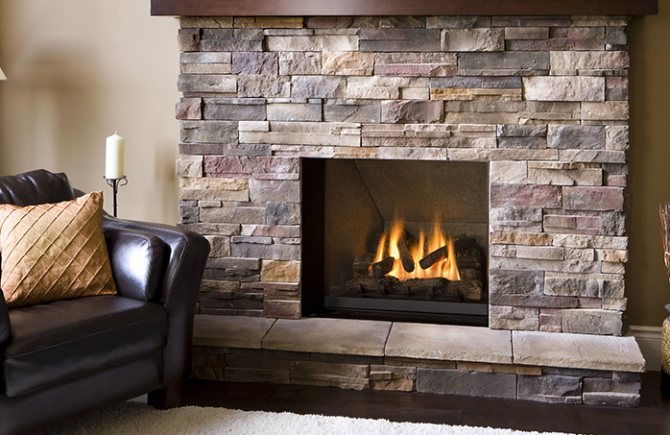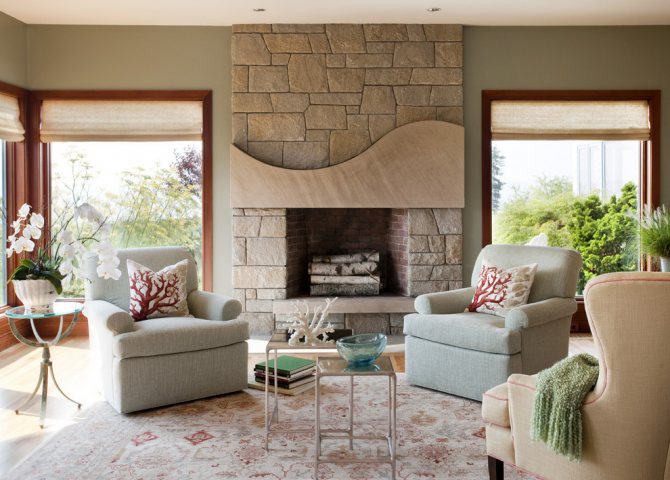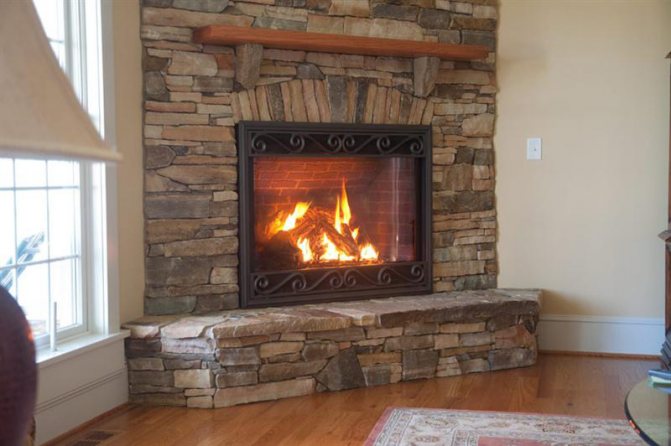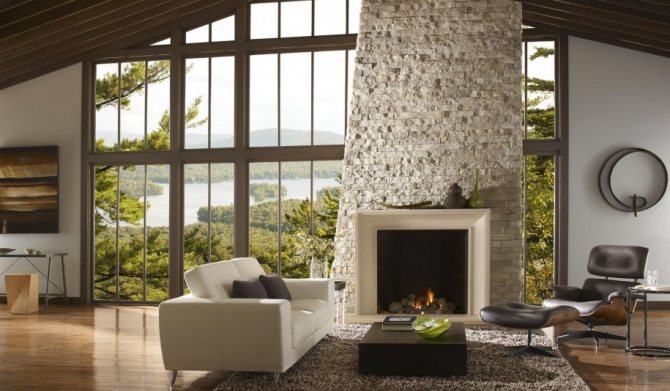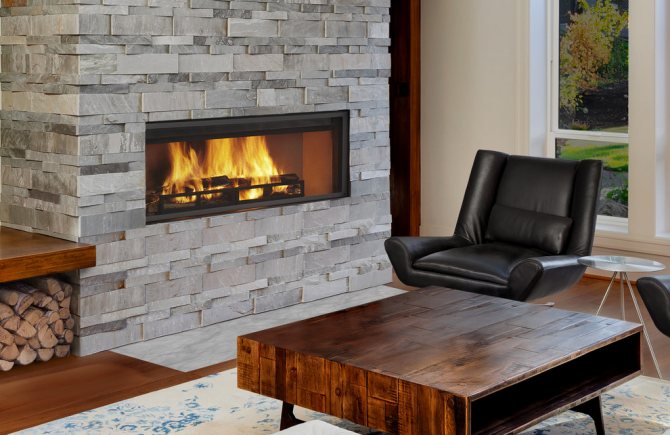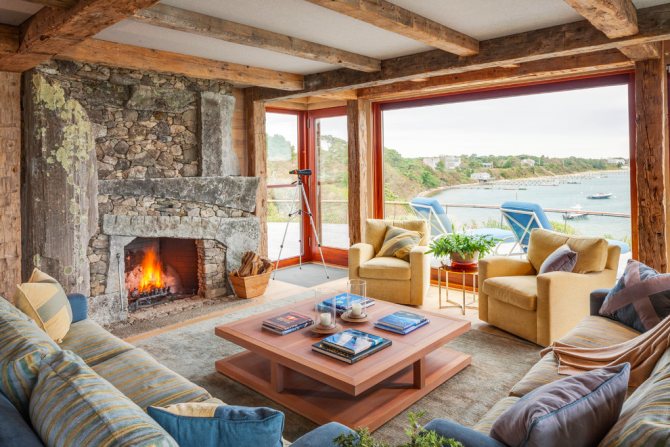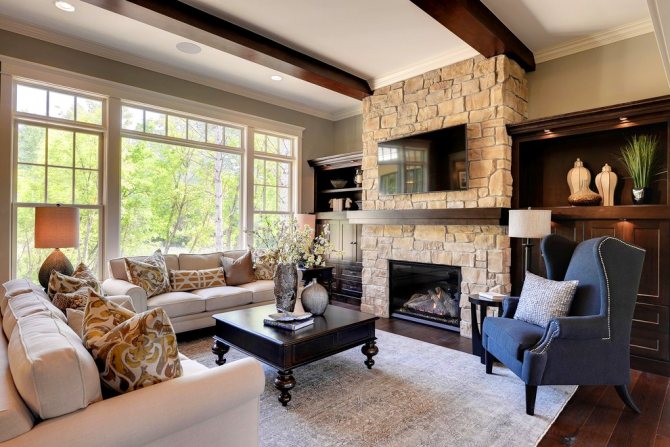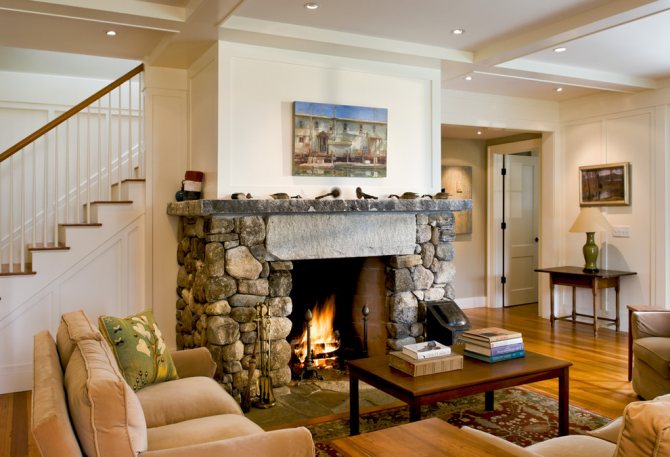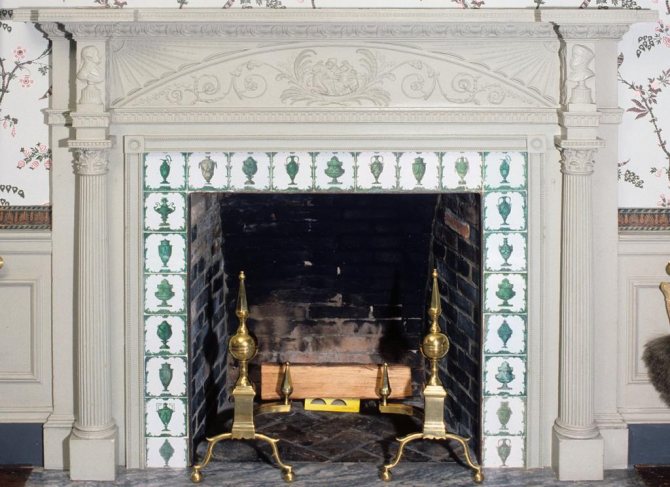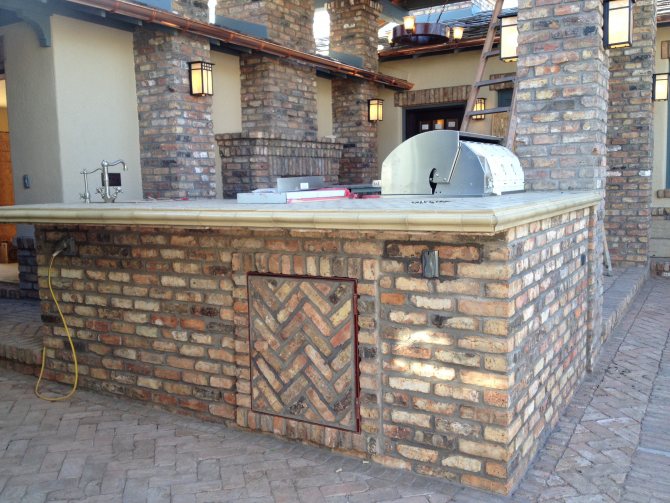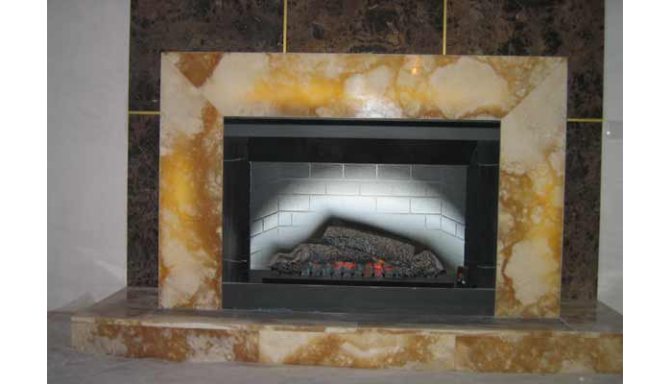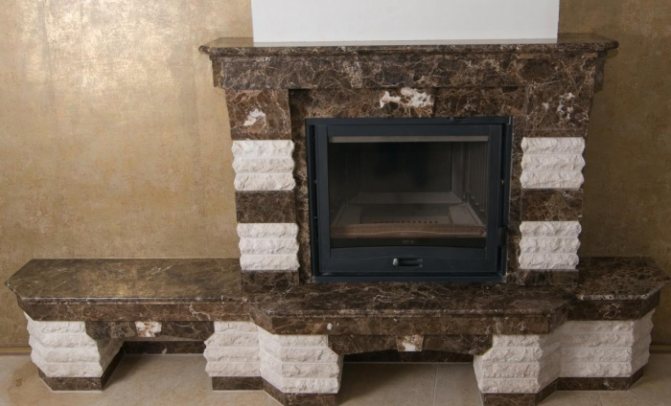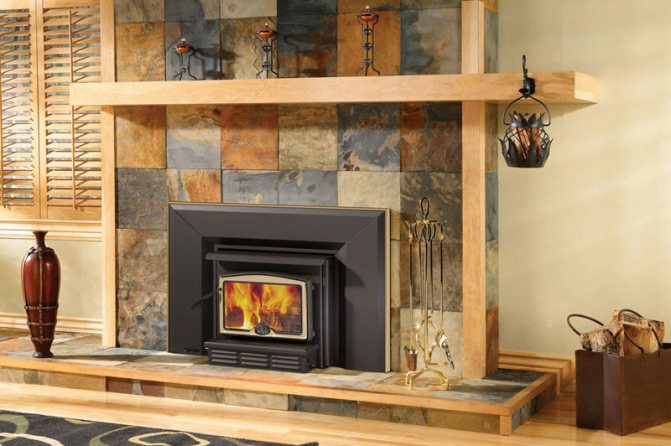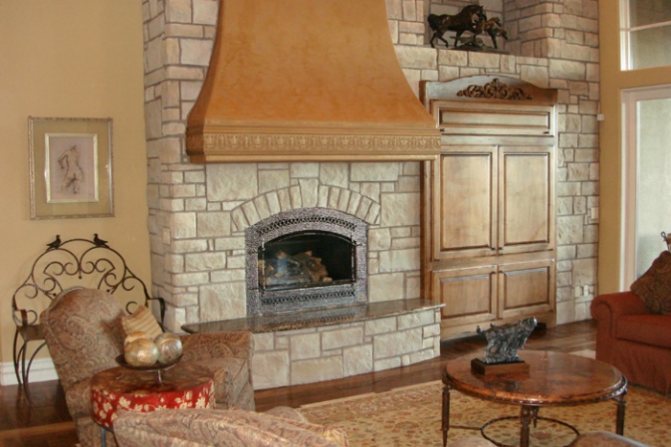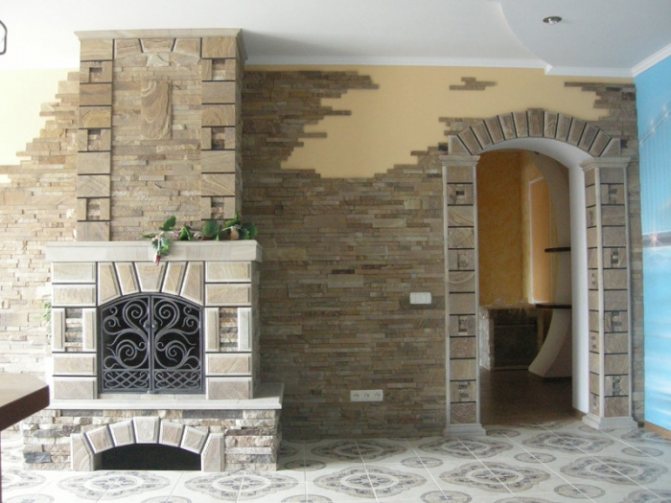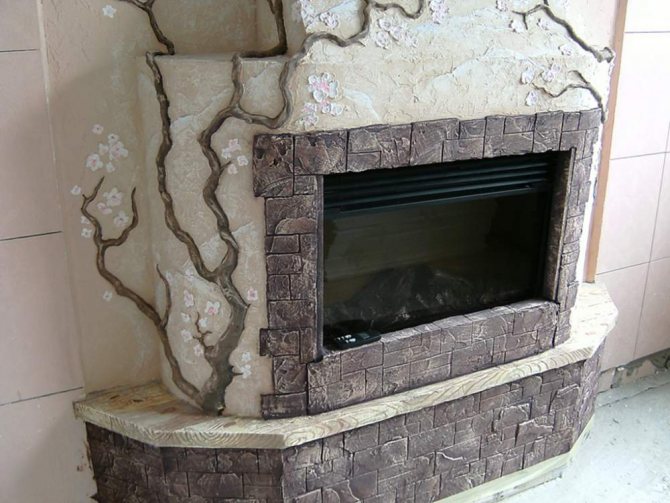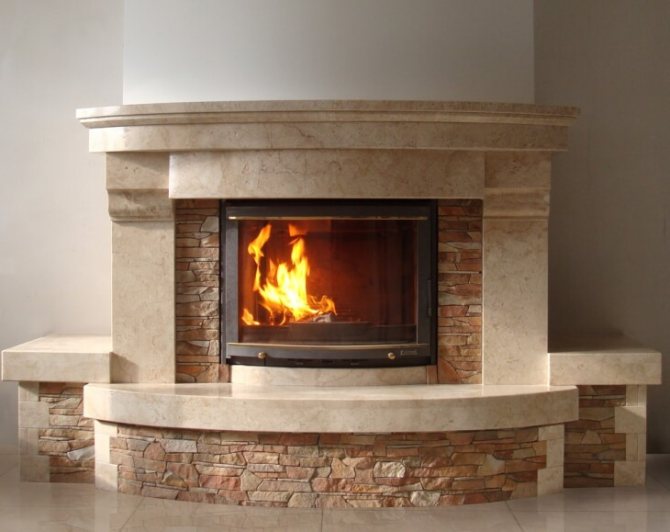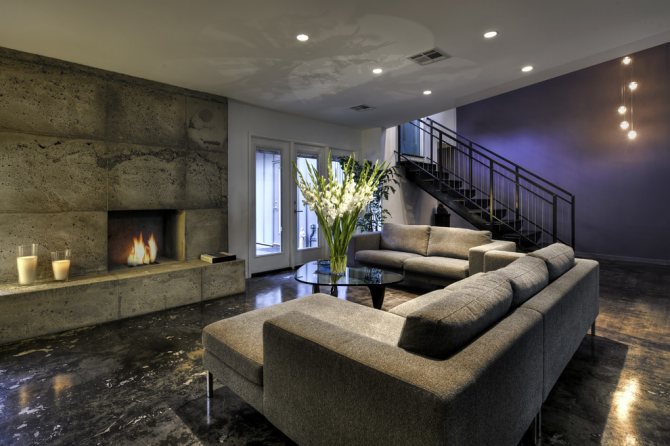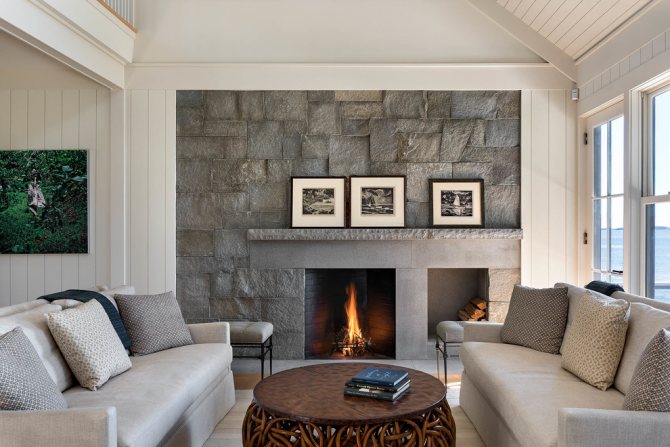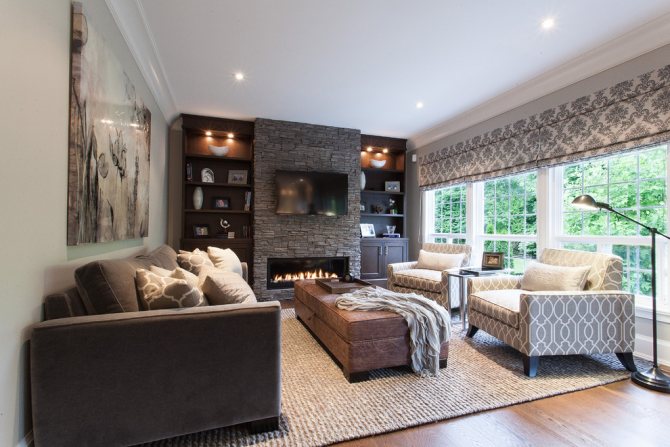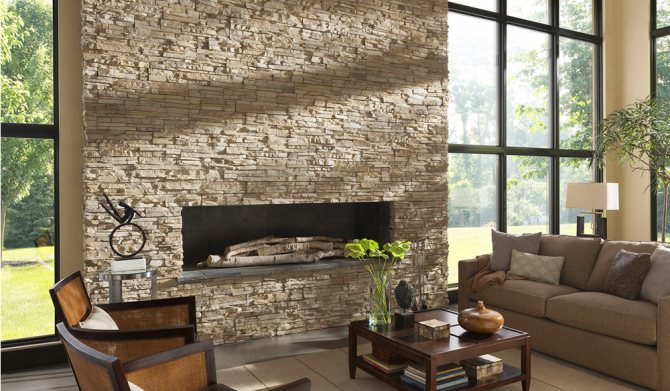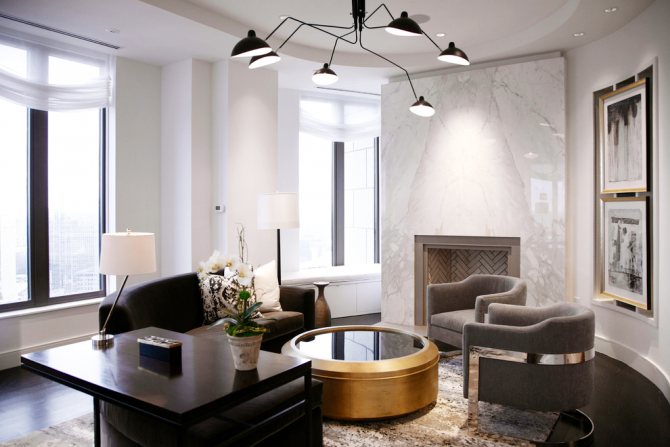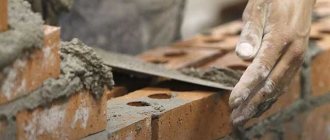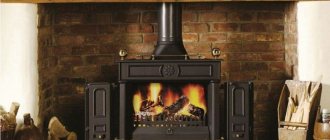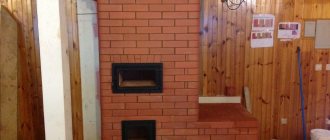Updated:
2016-09-19
Correctly chosen fireplace finish will help you maintain its aesthetic properties for a long time. But when choosing one or another type of styling, take into account your strength, whether you can make the cladding with your own hands or will have to resort to the help of a master. The most popular and durable finishes today are tiles, natural minerals and porcelain stoneware. Thanks to a wide range of such materials, you can make a fireplace in any style, and by doing the cladding with your own hands, you significantly save money, both for decoration and masonry.
Fireplace decoration
There is a list of rules to be followed when working on decorating a fireplace with an artificial stone:
- d

This type of material can be used for cladding wooden, metal, brick and other structures; - finishing is performed when the air temperature in the room is at least +5 degrees;
- the artificial stone should be started from the top of the stoves, gradually going down. This is required to avoid contamination of the material at the time of facing;
- to fix the parts, it is recommended to use a solution or glue, which was advised by the manufacturer;
- to cut the stone, it is better to use a metal hacksaw with a fine bore.
Features of natural stone for fireplaces
Despite the high cost, natural stone for fireplaces has always been in demand. This was facilitated by its qualitative characteristics. Among the main advantages of natural materials are:
Environmental friendliness
It is important that the facing stone for the fireplace is environmentally friendly. Rocks and minerals are composed exclusively of natural components. With their constant heating, no harmful substances are released into the air. Such coatings do not melt, so there are no decay products.
Fireplace decoration with limestone, natural stone


Strength
Natural stones are highly durable. Under mechanical or thermal impact, it does not form:
- Cracks.
- Scratches.
- Skolov.
Fireplace decoration with natural stone granite
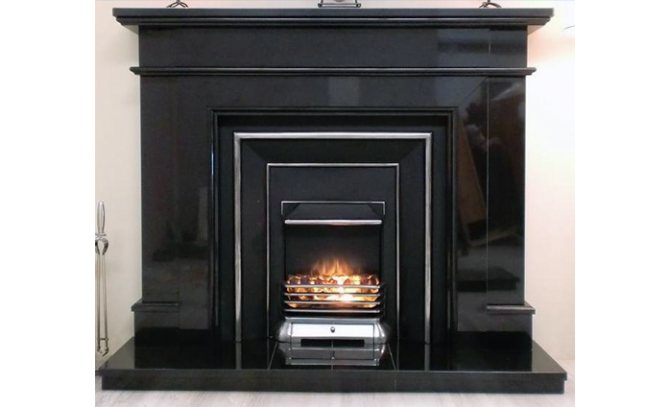

The smooth, even surface does not allow dirt to enter the porous structure. Dust can be easily removed without much effort
Long service life
High-quality natural stone for the fireplace is durable. Subject to the basic rules of care, such a finish will retain its aesthetics for a long time. The characteristics of the stones do not lose their quality over time. They do not require replacement for up to ten years or more.
Excellent quality
Regardless of the place of extraction and the individual characteristics of certain rocks, they are characterized by high quality. In order for the stones to retain their properties, they are amenable to special processing:
- I will burn.
- Impregnation.
For each type of material, unique technologies are used, certain compositions and a different number of hardening stages.
Natural stone in fireplace decoration
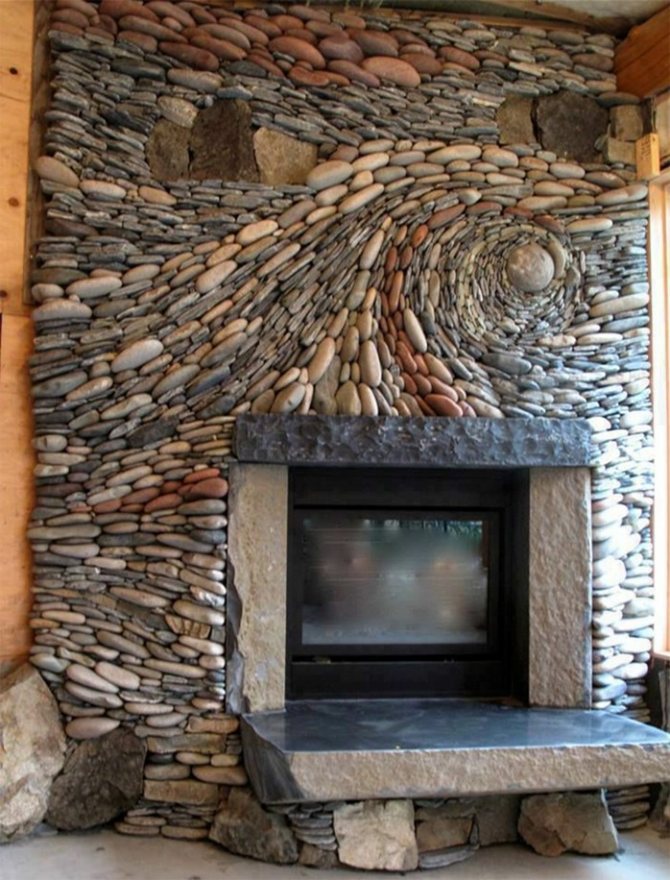

Variety of textures
Natural stones for the fireplace, photos of which you can see both on our website and on the Internet, attract with an abundance of textures and shades. You can choose a mineral whose surface will be:
- Matt.
- Rough.
- Glossy.
The color depends on the characteristics of the breed. Stones are dark and light, monochromatic or colored, with ornate stains and blotches.
Fireplace lined with natural stones


Surface preparation
You should understand what you need to pay attention to when making facing of different surfaces:
- wood coating is very susceptible to moisture destruction, therefore, it should be covered with waterproofing, for example, pigment, before processing with artificial stone;
- an important next step will be the installation of the plaster mesh with special fasteners. To do this, you need to make holes in the masonry with a puncher and insert self-tapping screws into them. Caps should be put on caps. Under such circumstances, the mesh cannot fall off under load. The fasteners should be about 15 cm apart vertically, and horizontally - 5 cm;
- the plaster on the mesh must be adjusted in such a way that its layer is 1 cm. It must dry completely, after which it is worth continuing to work.
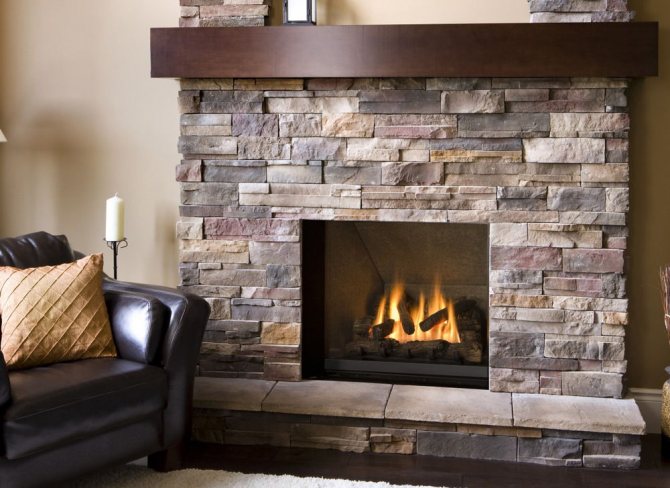

All the same actions can be carried out when laying artificial stone on a concrete or metal surface, with the only difference that waterproofing will not be required
Necessary tools for work:
- self-tapping screws or nails for fastening elements;
- spray gun for moistening before laying the fireplace surface;
- construction hammer and trowel;
- grinder, drill;
- a bar with a flat surface;
- utensils for mixing the solution.
It should be remembered that masonry is carried out only on material that tolerates high temperatures. Clay works well for these purposes.
Benefits of natural stone
Decorative finishing of a stove, fireplace with natural or artificial stone, baked clay, ceramic tiles, porcelain stoneware has the following advantages:
- high strength;
- long service life;
- environmental friendliness;
- solidity;
- resistance to high humidity and temperature extremes
High-quality decoration of a fireplace with decorative stone is not a cheap pleasure.


The decoration of a high-tech decorative fireplace is associated with some details. For example, modern materials and innovative technologies are used. Options for modern heating devices


Depending on the design features and location of the heating device, four types of heating devices are currently distinguished:
- wall-mounted;
- corner models;
- built-in structures;
- island models
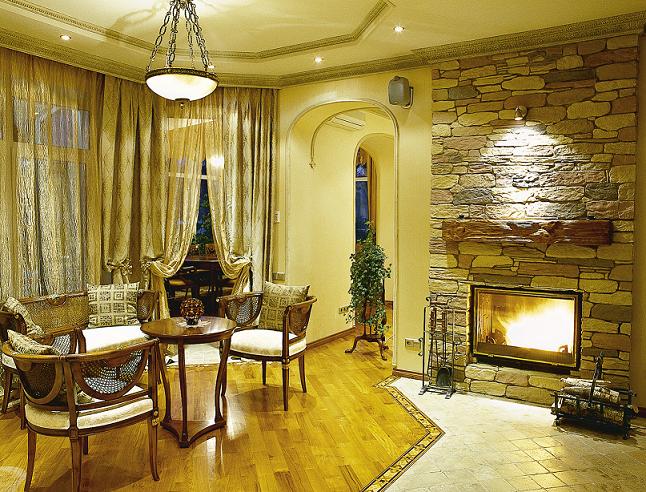

Wall-mounted fireplaces are located mainly in the center of the room. Such models are large in size, therefore they are suitable for heating living rooms with a large area. It is the wall fireplace that interior specialists make the basis of the interior, and around it they have a soft corner for family rest.
Corner models are built into the corner of the room. Since they are much smaller in size, decorating a fireplace will require much less finishing material.


The built-in fireplace has a chimney and a firebox in the masonry of the wall, which implies the use of a significant amount of cladding material. Outwardly, it protrudes in thickness by no more than half a brick. Designers prefer to use the same material that was chosen for the wall cladding to decorate such a fireplace.
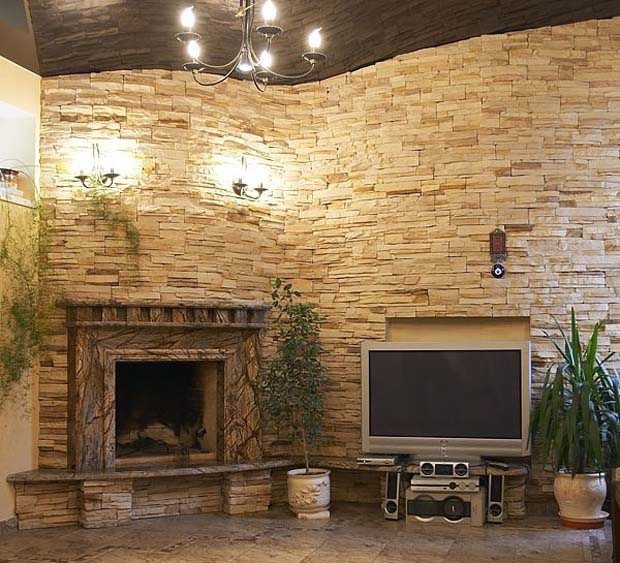

An island fireplace is comparable to a pool with low sides. There is a firebox inside it. To remove smoke, a suspended hood is installed above the outlet. Decorative finishing of fireplace stoves of this kind does not require a large number of decorative stones.


A back-to-wall and corner fireplace should have the following elements:
- firebox for burning firewood;
- smoke collector through which smoke enters the chimney from the firebox;
- portal decorated with decorative material;
- draft guaranteeing chimney
Discussing how to decorate a fireplace with decorative stone, we note that only the chimney and the portal need it.


An important point of work is the beginning of brickwork
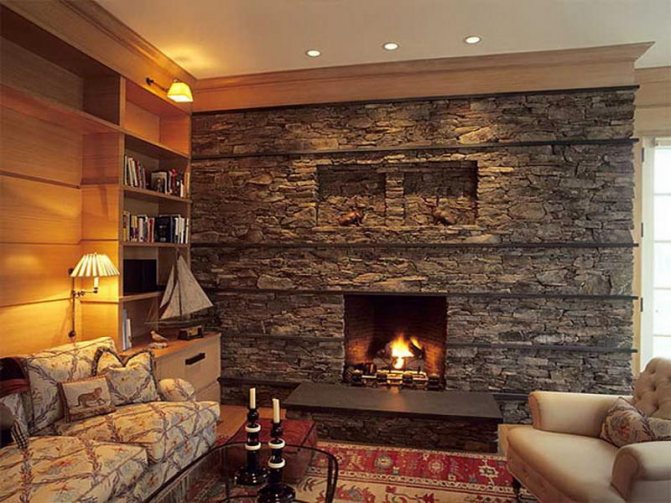

At the very beginning of the processing of the fireplace with artificial stone, the decoration begins from the corner of the fireplace. In the process of work, you need to alternate material that has different lengths.
First, the largest parts of the stone are attached, using a small amount of mortar for this. This will make it easier to lay the material in the future.
With a trowel, apply a solution of 1.5 cm layers on the stone. Make sure that the surface is evenly covered.
When laying the stone, lightly press on it, moving it to the desired position. This will fix the element better and fill the seam completely.
If you are doing the cladding in a very dry room, then the surface of the fireplace and the inside of the artificial stone must be moistened with a wet brush or spray bottle.
If you are using seamless masonry, then the material should be moistened, regardless of the room temperature.
Finishing options
The quality of facing fireplaces with natural stone depends not only on the chosen material, but also on the skill of the master to work with it.
Models made of several types of stone at the same time look great. So, the lower part of the fireplace, designed for storing firewood, can be made of rubble. It is better to overlay the chimney and the firebox itself with limestone. It has a pleasant beige color and will add lightness and grace to the portal.
If you want to give the fireplace a sophisticated aristocratic look, use dark granite. Is there natural wood in the decor of the room? Granite in burgundy and brown shades will suit you.
The stone for facing the fireplace is also light. White marble looks very good. Such a portal will be a great addition to a spacious classic-style room.
How to properly perform artificial stone decoration
There is no big difference in cladding with artificial and natural materials, the laying is carried out according to an identical scheme.
For an effective cladding outcome, it is recommended to place all parts of the future structure at the work site:
- when installing artificial stone, it is required to alternate types, size, change colors and texture of the material so that the fireplace looks natural;
- it is advisable to start laying from the top of the fireplace in case joining will be used in the future;
- the seams must be made when facing the same size, but make sure that they are not very even. Ideal result - seams of different thickness, located in the same plane. Avoid placing them horizontally one under the other;
- the stone can be uneven and thick. This does not affect the finished appearance of the structure.
When the artificial stone has a rectangular shape, special attention should be paid to the vertical seams, controlling the intersection of these lines with the horizontal ones. It should be done at a 90 degree angle.
Heat-resistant adhesive for lining ovens
It is not enough to purchase heat-resistant tiles; the issue of choosing an adhesive is no less important. Of course, the glue mixture must also be "immune" to high temperatures. Perhaps someone is now thinking about formulations for underfloor heating. Yes, there are many of them, but, alas, they are not suitable for fireplaces and stoves - in our case, you should choose more heat-resistant mixtures.
"Furnace" adhesives are able to withstand temperatures from 70 to 1500 degrees, most up to 150-400. Considering that the surface of stoves and fireplaces heats up to 100-120 degrees, choosing the appropriate mixture is not very problematic. The grout must also be heat resistant.
By following the recommendations for choosing refractory tiles for stoves and fireplaces, as well as related materials, observing the technology of facing, you can be sure that ceramic decorations will not fall victim to temperature for many years.
Correct implementation of the jointing


Do not use mixtures with which the tiles are laid.
To fill the seam completely, you need to use a bag made from a regular plastic bag with one corner cut off, with the hole slightly smaller than the width of the seam.
After filling the bag, you should press on it and squeeze out the solution as little as possible so that it does not fall on the outside of the material.
After the mortar begins to harden, you need to remove the excess with a trowel.
Types and devices of fireplaces
By their design and location in the interior, fireplaces are divided into 4 types:
- Wall-mounted - located against the wall of the room, mainly in its center. Such models are usually the largest, designed for heating large rooms. The wall-mounted fireplace is the dominant feature in the interior and immediately catches the eye. Several armchairs can be placed around it and the whole family can relax.
- The corner fireplace is mounted in the corner of the room and is usually inferior in size to the wall one, so less material will be needed for its decoration. But this design creates a completely cozy atmosphere and will allow you to sit around a small company.
- The built-in fireplace has a firebox and a chimney in the masonry of the wall, therefore it requires a minimum of materials for cladding. Usually it protrudes outward to a thickness of no more than half a brick, and its dimensions do not exceed 70 x 80 cm. As its decoration, you can use the material with which the wall is faced.
- The island fireplace does not adhere to the walls of the room in any way, it is open from all sides, looks like a pool with small sides, inside which there is a firebox. To remove the smoke, a suspended hood is installed above it. The decoration of such a fireplace is required only for the side boards, so a very small amount of decorative stones is needed.
A wall or corner fireplace has the following elements:
- firebox where firewood is burned;
- smoke collector designed for smooth transition of smoke into the chimney;
- the portal, most often of the U-shaped form, is the facade of the fireplace, decorated with decor;
- a chimney that draws smoke outside and provides draft, which is also lined with decorative stones.
Thus, finishing is needed only for two parts of the fireplace - the portal and the chimney. But many options for such home stoves may contain additional elements: compartments for firewood or decorative shelves for small items.
Types of fireplace cladding
Professional specialists use tiles, ceramic tiles, stone as decoration.
Fireplace cladding - ceramic tiles
Facing the fireplace with tiles is easy, and therefore anyone can cope with it. The main task is the selection of high-quality and reliable material and strict adherence to the main stages of work. Most often, tiles are used as a decorative design for fireplaces:
- ceramic granite;
- clinker;
- unglazed;
- pressed glazed.
Each of the above materials is characterized by strength, high wear resistance, excellent appearance and resistance to high temperatures. As for the size of the tiles, large ones will be easier to install, but they are more difficult to fit into ledges and various niches. You should be very responsible about the selection of glue, and therefore it is better to purchase a heat-resistant base that does not allow the adhesive layer to deform.
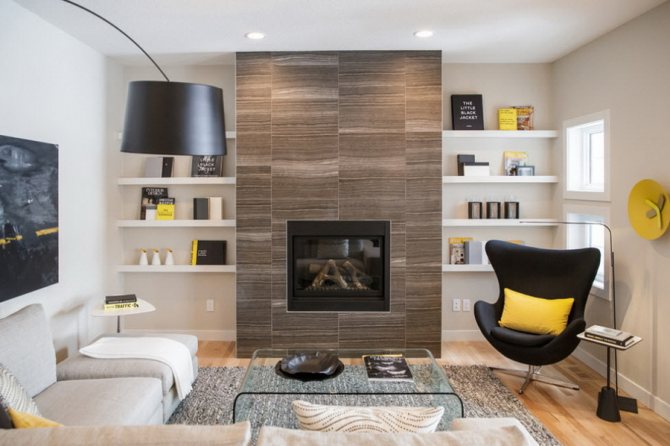

Fireplace cladding - tiles
For several centuries in a row, facing a fireplace with tiles has been relevant and fashionable. Constructions decorated with tiles with or without a pattern always look original. The main difference between tiles and standard ceramic tiles is the presence of a rump. This kind of protrusion helps the tile to gain a foothold on the fireplace and keep it warm.
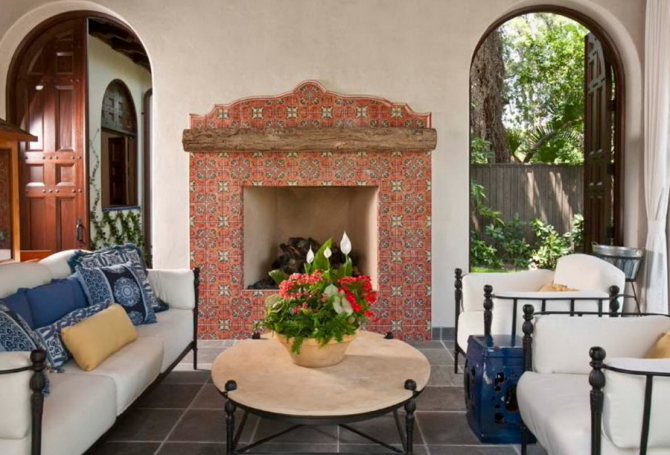

Wood cladding fireplace
This is a good type of finish, but it can only be used for modern electric fireplaces that perform a decorative function. The tree can be shaped into any shape at no extra cost.However, it should be understood that a tree can only last for a long time with proper care.
Since these structures are lightweight, no additional foundation is required for them.
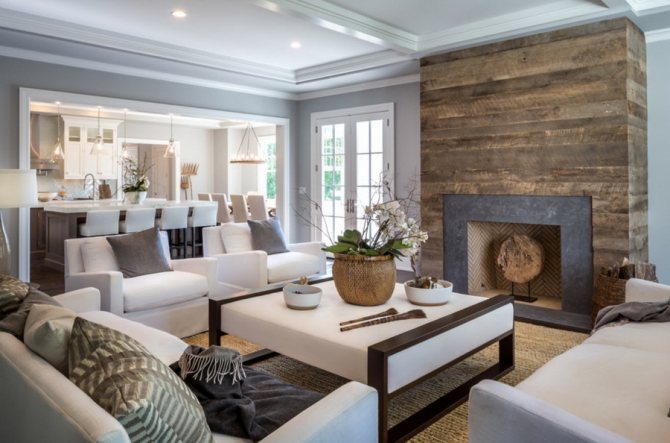

Stone fireplace cladding (natural and artificial)
Natural stone is an ideal material that meets all the requirements for finishing any fireplace. It perfectly tolerates rather high temperature indicators, is characterized by a fine-grained structure and gives off heat to the room well. In addition, one cannot fail to note the durability and environmental friendliness of the material.
The undoubted advantages of the stone are natural color and beautiful texture. Perhaps the only drawback is the high cost of the material. That is why most of the craftsmen began to use artificial stone in their work, which is not inferior in all respects to natural.
Thanks to modern technologies for processing clay, you can get figures of any complexity that will not be inferior in design to expensive natural stone. The creation of heat-resistant mastic made it possible to simplify the fireplace cladding.
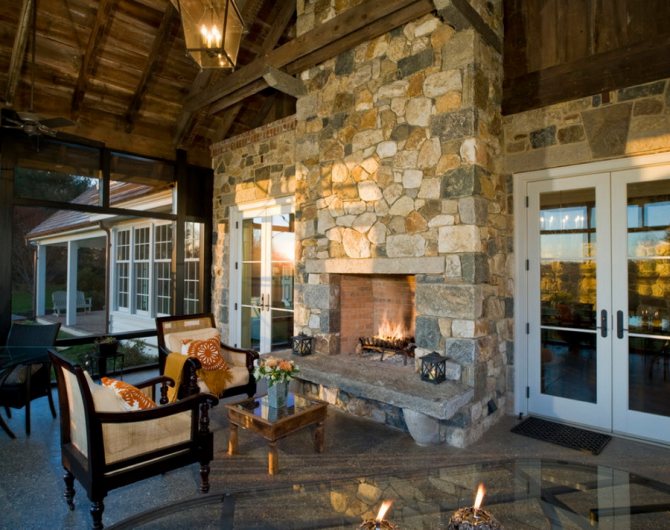

Fireplace cladding - marble
Many craftsmen prefer marble cladding of fireplace structures, as it remains the most exquisite material. The material is prized for its unique design and it never goes out of style. If you use it correctly, experts are able to get an amazingly beautiful mosaic when creating a home. Facing the fireplace with marble emphasizes the taste of the owner, making his home cozy and modern.
Tile marking (designations)
The labeling (marking on the tile) on the packaging will help you to tell which tiles to use for facing the ovens. Depending on the type of tile, the following can be used:
- Letter "T" - denotes heat resistance.
- The numbers 1 and 2 on the background of the flame show the number of burnings. The higher the better.
- Letter "E" and number - marked with water absorption. The higher the number, the more moisture the surface can absorb. For a furnace, the indicator should not exceed 3%. For comparison, the water absorption of granite is 0.5%.
- The designations "A" or "B" on the packaging or the inside of the clinker tiles indicate the technology of their manufacture. Option "A" is more technological and has clear dimensions.
- The PEI index in grades from I to V will indicate the wear resistance of the tile. Any one can be used for the oven.
- The EN 122 standard, ranging from A to D, denotes the product's resistance to chemical attack.
Related article: Original ideas for home: painting with stained glass paints on glass
Tile cost
The price of facing tiles and the reputation of the manufacturer are far from the last argument when choosing. Masters advise not to save on purchases, because the constant replacement of cheap tiles will ultimately turn out to be more expensive. The cost of tiles by type is shown in the table.
Based on this, it is easy to decide which tiles are needed for facing ovens. But do not forget that the chosen tile should correspond to the general style of the interior of the room.
How to choose the right material?
Almost any of the natural stones available on the construction market can be suitable for decoration, and they all have unlimited design possibilities. Materials differ in terms of durability of use. The most short-lived are limestone and colored marble - they change after 30-70 years.
Note! The service life depends on the external conditions and factors that affect the material, as well as on whether the fireplace was properly looked after.
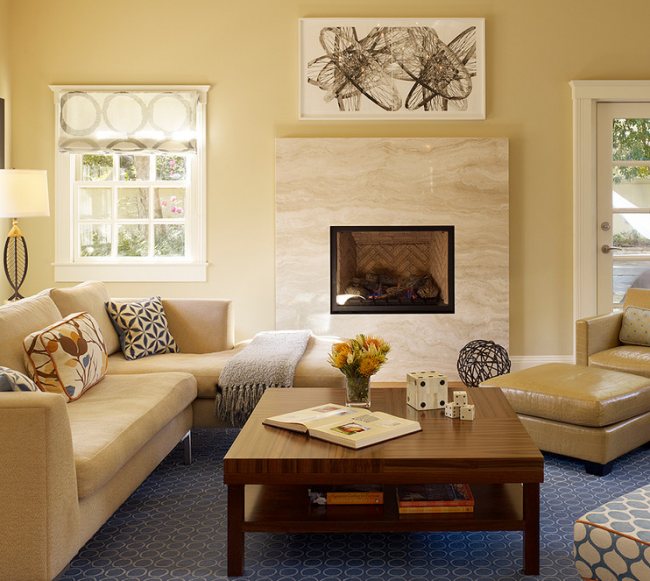

Marble veneer for a sophisticated style
On a note! The most popular options are granite and marble. The first is a durable rock that can be easily polished and processed. However, such material has a rather high cost due to the laboriousness of its extraction.
Marble is not as popular as granite, but it has a special beauty and allows designers to create bright, extraordinary masterpieces.
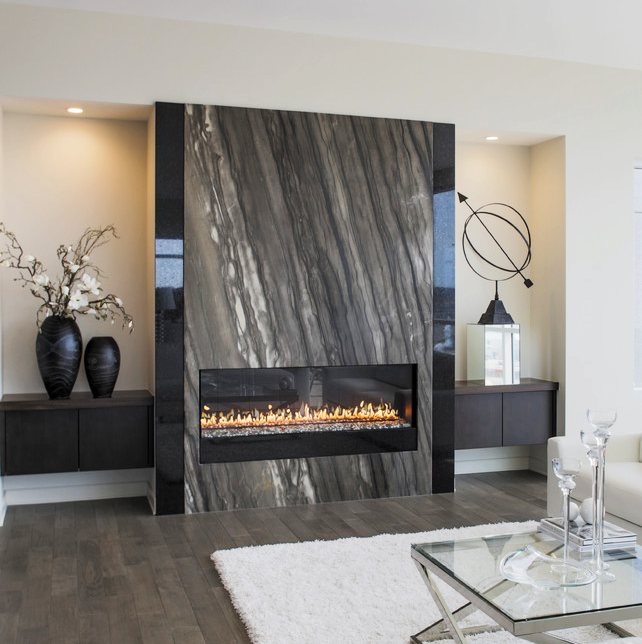

Stylish solution using granite
On a note! In addition to these materials, limestone, tuff or sandstone are often used for facing. The latter has high heat capacity, which ensures its rapid heating. Such a stone keeps heat longer.


Fireplace decorated with limestone material
When choosing a material for cladding, it is worth considering the following criteria:
- The price of goods depends on the manufacturer and will be significantly higher for imported manufacturers.
- Availability of a certificate of compliance with sanitary standards.
- An important point is the good reputation of the manufacturer, the long term of work in the market. An experienced manufacturer will provide quality products.
- The strength of a stone is influenced by its structure.
- The packaging must be branded with the manufacturer's logo.
- Pay attention to the date of production.
The quality of the adhesive for finishing the fireplace is also important. Choose only a reputable supplier and a composition recommended by the stone manufacturer. If an artificial turf is glued, then a specific glue based on it is usually recommended to it, which provides a strong adhesion of the material to the surface.


